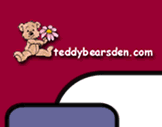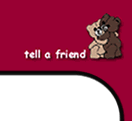|
GETTING READY TO STUFF AND JOINT YOUR BEAR
Tips & Hints | Bear Making Terms
Stuffing Materials
- Stuffing sticks are available, although the handle of a wooden spoon or chopstick is equal to the task.
- Woodwool (excelsior) has been used for years. This thing finely shredded wood looks like straw. These days, woodwool is available from specialist suppliers. An important use is for stuffing the nose which makes embroidering much easier.
- Polyester is the most common filling available and is extremely easy to use. There are many different grades and qualities. A top quality high loft product will fill the bear to a firm stage and not form lumps. Be choosy because no one wants a lumpy bear!
- Kapok is a material that is very silky to touch, but as it is handled, the fine fibers float around, so wear a dust mask. Kapok is best used for small and miniature bears since it gives a 'weighty' feel as it is packed in.
- Pellets are available in plain and scented varieties. These 'food grade' pellets (means they pass harmlessly through if swallowed) create soft stuff squishy tummies or add weight to bear bottoms and limbs.
- Glass beads are easy to use. Beads add weight without a "bean bag" feel to your bear. Glass beads are recommended over steel shot due to health reasons.
- Barley, rice and lentils may seem like good fillers - Careful!! insects such as beetles and moths may not only be attracted to the mohair but also the free lunch inside....
- Polystyrene (foam) beads used in bean bag chairs are not suitable for stuffing bears.
- Foam chips are REALLY REALLY messy and do breakdown overtime (foam "powders out" .. probably not a good choice for filling).
JOINTS
The jointing system you choose depends somewhat on personal preference, on "the look" you want to create and who will be caring for the teddy bear...
Plastic "Doll" Joint

These are the parts you need:
Plastic joints are light and easy to install. Since they are washable, they are excellent for teddy bears made for small children. You can't make fine adjustments on joints with a flange system.
Screw Joints

For each joint you need:
Screw joints are easy to install and can be fine-tuned.
Cotter-Pin Joints

For each joint you need:
The disks are connected by the cotter pin, whose ends are bent like a snap or a crown with needlenose pliers, to secure them. It takes some practice to learn to do this. You can flatten the loop of the cotter pin to a T or thread a small washer to the loop to keep from pulling it through the washer.
WHAT SIZE TO USE?? Well that just depends! Of course you will be limited somewhat by the dimensions of the upper portion of your bear limbs. Otherwise you can really decide yourself. Most patterns make suggestions, but as long as the disk fits inside the space in the top of the limbs you can be creative.
For almost all of the jointing systems in order to get the stuffed head jointed to the body you are advised to glue the assembly which will end up inside the head... then of course its tough to tighten down and you get a nodder bear even if you didn't plan on it. We recommend the head bolt joints which come in three sizes (small, medium & large).
Head Bolts
Sew and stuff the bear's head completely. Install the pre-attached lock nut and bolt assembly, washer, and joint disk inside stuffed head. Gather the neck opening and secure the joint. Insert the bolt through the body opening; place the disk, washer, and lock nut onto the bolt. Using an open ratchet wrench and the key provided in the kit, tighten the lock nut to the desired tightness.
|
Many, many artists prefer to finish all the limbs before jointing the body. Use the Head Bolts or prepared epoxyed discs. This means you can place the disk and bolt in limb, stuff and close limb before attaching to the head.
|
Pop Rivet Joints
Easy to use, extremely durable and not very expensive once you have the pop rivet gun. In order to install you need access from both sides of the joint (like tap bolts and nuts).
Miniature Jointing Systems
are similar to those for the bigger teds - just smaller!
String Jointing
Can often be used the the "wee" ones. The limbs will still move but should not be twirled the entire way around. One method for string jointing is show below. Just follow the arrows for the travel of your needle. Use dental floss or really strong upholstery thread.

"Take a stitch through the inside of one limb, thread needle through the body - out the other side - through the inside of the other limbs - back through the body and out. Tie threads securely and bury the threads"
Crown Joint
Cotter pin joint assembly may appear daunting at first, but the technique can be easily learnt. Takinga limb with joint sewn

in, push the cotter pin through the hole in the body. Inside the body, place another hardboard disc onto the cotter pin followed by a washer.

Using pliers, spread the two legs of the cotter pin apart. Grip one side of the pin halfway with the pliers and twist down firmly

into a curl. Repeat with the other side, and test for tension. If the joint feels a little loose, the curled pin can be tightened.
|
More on Stuffing:
We read somewhere that a stuffing conjures up a tough aggressive process so more suitable would be to call the process shaping or sculpting.
-
Start with the head. Decide if you intend to fit plastic safety eyes or the glass/shoe button type. Plastic eyes must be put in place before shaping the head.
-
Place small amounts of polyester filling into the nose area, placing them as firmly as possible. Continue to add filling little by little into the middle of the head first and then placing bits around. Do not use large handfuls since this will create unevenness and empty pockets which will cause your bear to droop later on.
-
As the head fills, use your stuffing stick and firm the filling down evenly and frequently as you work. At first the filling will be bouncy but as the head fills it will become more firm and allow you to shape the head.
-
Stuff the nose area very firmly. It will be very difficult to embroider on a soft scrunchy nose.
-
When you believe the head is filled, be sure to stuff the stock repeatedly into the under chin area and into the nose tip. really be sure the nose is firm
-
Fill the head approximately 1/2" (12mm) of the neck edge.
-
Complete final inspection to sure that there are no lumps or hollows. Fix the problem areas now BEFORE you close the neck edge.
-
Once you are satisfied then insert the head joint.

|
- Invert the head joint and lay the joint on the stuffing.

- Hold the head still upside down and with joint in place. Stitch a running stitch around the neck opening using extra long thread.

- Pull the stitches tightly around the joint pin to gather the material around the joint pin. Stitch from side to side through the gathered fabric. Be sure there are no gaps which would allow joint to slide down.
- The most important part of this work is to be sure that the joint cannot slide out.
- Arms and legs are jointed in a similar fashion... and you decide whether to fill the limps with stuffing before or after completing the jointing to the body.
One of the best tips we have ever heard is the one which stabilizes the joint hold area and makes locating the right spot inside the limb and body ever so easy.
-
be sure the joint holes are well marked.

- After stitching and before turning, glue (white glue is fine) 1/2" x 1/2" ultra suede pieces directly over the joint holes
- Allow to dry at least overnight.
- Use the awl to create the joint holes one in each arm and leg. With the obyd in a flat position, push the awl right through both sides to make arm and leg joint holes. This really helps to ensure that the legs and arms are positioned evenly from side to side.
|
|






